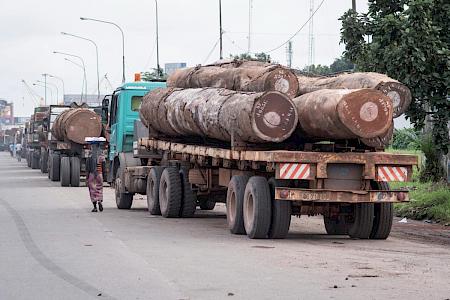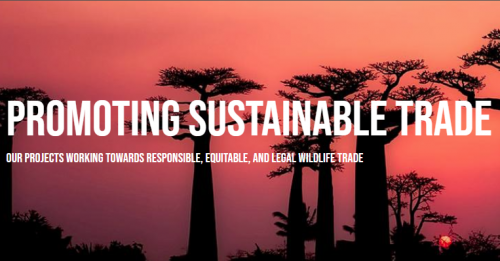Unparalleled attention and investment are vital for a Green, Healthy and Resilient Future for Forest supply chains
As world leaders, the private sector, and experts met for the final day of the 15th World Forestry Congress on Friday and the United Nations Forum on Forests begins today, fulfilling funding promises made during UNFCCC’s CoP26 to tackle the illegal timber trade and accelerating the implementation of sustainability strategies must be at the top of the agenda says TRAFFIC.

“To secure a viable future for the health of people and the planet, multilateral efforts, like CoP26, the Paris Agreement and proposed targets of the post-2020 Global Biodiversity Framework, require unparalleled investment. Worldwide stakeholders must urgently provide the resources for an effective rollout of an integrated strategy in all these agreements - to end deforestation and forest degradation that fuel climate change and biodiversity loss.”
Richard Scobey, TRAFFIC's Executive Director
Every year, timber exported from the Congo Basin provides livelihoods to local communities. The forestry sector is essential to regional economies. With some of the world’s richest biodiversity hotspots, the Congo rainforest is home to approximately 10,000 species of tropical plants, 30 per cent of which are unique to the area. Not to mention, as the world's second-largest tropical rainforest, holistic Nature-Based Solutions involving these local communities, will be vital to mitigate and adapt to climate change.
Yet surging demand for tropical wood, primarily from Asia but also from Europe and America, exacerbated by corruption, resource mismanagement, and ineffective regulation, is making it all too easy for criminals to harvest and trade in threatened timber illegally. And it's not just the Congo Basin; estimates suggest that forestry crimes, including corporate crimes and illegal logging, account for US51 – 152 billion annually worldwide.
Where should governments focus their investments?
Gaining a greater understanding of the timber supply chain can help pinpoint where illegal activity occurs so that potential solutions can be applied in source countries, during the transit of timber (typically via seaports) and in processing, before entering the consumer market.
“It is imperative that all links in international timber supply chains take appropriate measures to keep illegal timber out of the global marketplace. However, timber trade regulation is a complex issue, so ensuring that those involved understand their sustainability obligations is the only way to ensure our rainforests’ survival,” said Chen Hin Keong, Senior Advisor – Forest Governance and Trade.
Some challenges include a lack of guidance and enforcement on sustainable harvest and use, the inability to easily trace timber from verifiable sources, and a disparity between ambitious international and national goals and national capacity.
Chen continued, “In the last ten years, there has been progress in high-level action, such as EU’s FLEGT (Forest Law Enforcement, Governance and Trade) timber supply chain policies in Voluntary Partnership Agreement countries. Meanwhile, on the ground, the customs and law enforcement agencies tasked with cracking down on this illicit trade are still often without the vital tools and knowledge to establish whether the timber passing their borders is from legal and sustainable sources.”
Issues could be deconstructed with a suite of actions and tools. For example:
- Ensuring robust national legality frameworks, incorporating practical training
- Improving coordination, intelligence sharing and communications between relevant government agencies
- Supporting law enforcement and the private sector to understand timber legality
- Investing in wood forensics
- Support the development of an online timber tracker tool that TRAFFIC piloted in Tanzania
- Improving the scrutiny of financial flows in the timber supply chain
- Building greater cooperation between stakeholders to share the responsibility of legality and environmental and social equitability like seen at the World Hardwood Conference
- Developing CWPDA guidelines and codes of conduct for legal wood and forest products that enable buyers to make informed decisions
Investing in upscaling these strategies and tools, and committing to their effective worldwide rollout would make it harder for traffickers to trade illegal timber and work towards a more transparent and viable future for forest products, tree species conservation, local livelihoods and health and sustainable government revenues from their forests.
In tandem with these approaches, social and behavioural change communications are necessary to reduce the motivations behind purchasing products containing illegal and unsustainable timber products.
Securing legal and sustainable forestry trade: beyond timber

However, these issues are not confined to just timber. With an increase in value of more than 75 per cent due to growing demand in the last two decades, investment in strategies for the sustainable harvest of non-timber forest products (NTFPs) such as wild-harvested resins, fruits, nuts and medicinal plants will also have a significant impact on the survival of these ecosystems and the people that depend on them.
“Moving wild plant and other non-timber forest product supply chains towards full sustainability could transform the lives of millions working within some of the most impoverished global communities,” said Anastasiya Timoshyna, Senior Programme Co-ordinator – Sustainable Trade.
Thousands of plant species used in everyday pharmaceutical, cosmetic, industrial and food products are at risk. Of the 21 per cent of medicinal and aromatic plant species whose vulnerability status has been assessed, nine per cent are considered threatened with extinction.
Ensuring the sustainable use of wild species, including wild plant resources in everyday products, is an important strategy to the fruitful continuation of worldwide forests conservation, and tackling challenges to human health, biodiversity loss and climate change.”
Anastasiya Timoshyna, Senior Programme Co-ordinator – Sustainable Trade
The varied social and ecological risks of a selection of wild plant ingredients used in everyday products showcased in the WildCheck report, emphasise the need for concerted and nuanced commitments and actions from industry, investors, consumers and governments, which can start with the #WeUseWild pledge.
TRAFFIC calls on all stakeholders to unleash the funding for vital tools and strategies
In the UN Decade on Ecosystem Restoration and as the world approaches the adoption of the UN post-2020 Global Biodiversity Framework, TRAFFIC calls on all stakeholders, including governments, the private sector and organisations in the forest supply chain, to invest time and finances into meeting the SDGs. In doing so, we can harness the potential for forest conservation, sustainable use and restoration to address climate change mitigation and biodiversity loss, and secure ecosystem services benefits for human well-being and the planet.
Some recent TRAFFIC work related to sustainable and biodiverse forests for the future:
- Leveraging legality along China’s timber supply to reduce deforestation
Reducing deforestation, illegal trade, and the associated economic and biodiversity impacts requires targeted interventions throughout the source, transit, and consumer supply chain. - Reducing illegal timber exports from Cameroon and Viet Nam
Working across timber supply chains to support and guide key stakeholders in their efforts to transition towards full sustainability and legality compliance for timber. - Targeting Natural Resource Corruption
Targeting corruption is one of the largest conservation and development challenges within natural resources sectors. Corrupt practices in the governance and management of natural resources result in the misuse or outright theft of public revenues, environmental degradation, reduced economic growth and enduring poverty. - Improving timber supply chains will help unlock sustainable production and consumption.
Since 2009, the volumes of Central African timber exports to China have increased by 60%. The country is now the top export destination for the Congo Basin timber. Beyond the international demand for tropical wood, there are additional challenges of domestic markets within the countries in the Congo Basin. - Private Sector Guidance
Recruiting private sector businesses in the journey towards sustainable wildlife trade is essential if we are to halt the ecological destruction affecting species the world over. - Himilayan Plants for People project
Wild-harvested medicinal and aromatic plants (MAPs) underpin Nepal’s traditional medicine systems and provide a critical source of income for low-income rural communities. Over 300,000 Nepali households commercially harvest and trade MAPs. - Wild at Home project and the WildCheck Report
“The vast majority of us are already using wild plant ingredients; we just don't know it. This project works to connect industry and consumers to the wild in their everyday products, to ultimately ensure that sustainability and good working conditions exist throughout supply chains,” Caitlin Schindler, Project Officer – Wild at Home. - FairWild
The FairWild Standard and certification system helps provide businesses, operators, producers and communities with best practice guidelines on how to sustainably harvest, manage and trade in wild plants.




